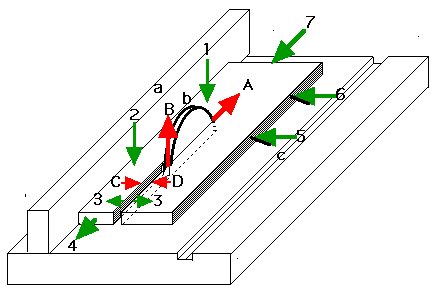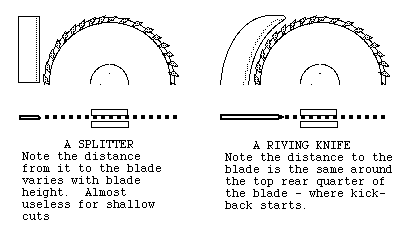(small print - The following are merely my observations and opinions and should be taken as such. I assume no responsibility for any use or misuse of this stuff by anyone, anywhere at anytime.)
THINGS YOU CAN DO TO MINIMIZE KICKBACK
Before we get to devices that can help reduce the likelyhood of a kickback you need to accept the fact that it's the loose nut in front of the saw that is most likely the cause of a kickback event. If YOU lose control of that board, bad things can happen. The best safety tool in your shop is your brain. Knowledge and the proper use of it is power. So BEFORE you turn on the saw run through a mental check list.
1. Is everything that you think is locked down actually locked down?
....A blade that moves either vertically or horizontally during a cut is
....an accident waiting to happen
....A fence that moves vertically or horizontally during a cut is an accident
....waiting to happen
2. Think through the cut you're about to make BEFORE you start the cut.
....If that liittle voice in your head is saying "I don't think this is a good idea!"
....then you better think through things again. Is there another, saferway to make
....this cut? Should I have a roller stand on the outfeed side? What about the infeed side?
....Is/are the roller stand(s) set to the right height? Is the path the board will travel clear of
....any obstructions THE WHOLE WAY? ( I put stuff on my saw table when I can't find
....a clear flat spot nearby). Having to stop in the middle of a cut, unexpectadly, is
....potentially dangerous.
3. Have whatever else you need ready to go. (Is that the right push stick to use
....for this cut? Is the featherboard set right and clamped tight?)
4. FOCUS on what you're doing and CONCENTRATE ON MAINTAINING CONTROL
... of the board THROUGHOUT THE ENTIRE CUT. Losing your concentration in the
....middle of a cut.is probably the most dangerous thing you can do now. You can lose
... control of.the board or worse yet, get your hand in where it can contact the spinning
.. .carbide.We're not talking fear here but rather respect. If you get bit, it's most often
....because you got careless and weren't respectful of the saw
5. Use ALL your senses. Often you can FEEL when something's starting to go wrong.
.....You can HEAR changes in sounds - a motor bogging down, a change in the pitch of the
.....blade noise if it's not cutting properly. You can SMELL when you're feeding the stock
.....too slowly and the blade's burning the wood. If your mouth is dry before you make
.....the cut, STOP and think through what you're going to do.
.....
Back to devices that can help reduce the things that can cause kickback. The Green Arrows in the diagram below can help minimize kickback.

Arows ! & 2 will hold the stock down on the table and away from the saw teeth that can fling the stock at you.
Arrows 3 prevent the stock at the back of the cut from contacting the teeth in the top rear quarter of the blade, the ones that can lift and fling.
Arrow 4 indicates a clear, unobstructed path on the outfeed side of the cut. Unitnended stoppage in the cut can break your concentration and you can lose control of the board. It also indicates things that will prevent the stock from moving back towards the front of the table.
Arrows 5 & 6 keep the stock pressed firmly against the fence IN FRONT OF THE BLADE.
Arrow 7 feeds the stock to the saw blade. Near the end of the cut it should a) control the board both vertically and horizontally and b) KEEP YOUR BODY PARTS SAFELY AWAY FROM THE SPINNING TEETH!
Feather Boards, Board Buddies (TM), Grip-Tite Guides (TM) and other such devices hold the board down and pressed against the fence (Arrows 1,2, 5 & 6). They also can apply force agains the board moving back towards the front of the table (Arrow 4) You'll want to set one or more of these devices in front of AND behind the cut. Ideally, they should not interfere with feeding the stock completely passed the blade, though most don't.
A Splitter, or better yet a Riving Knife, can reduce one of the major causes of kickback, the wood at the back of the cut coming in contact with the saw teeth in the top rear quarter of the blade. The splitter or riving knife should be able to be set within a quarter of an inch of the blade AND move with the blade when the blade is tilted. It should be made of something stiff but softer than the saw teeth (just in case it makes contact with a tooth or two) and be the same width as the kerf of the blade creates or a smidge thicker. The front edge should have a dull knife edge. It should have a way to align it with the blade and be easily removeable and reinstallable (is there such a word?) If getting it on and off is a PITA you're probably not going to use it and that's A BAD THING.

As you can see from the illustrations above, the splitter has a major shortcoming. It's close to the blade when the blade is set at it's maximum height but farther and farther away as the blade is set for shallower cuts. On a 10 inch blade it can be almost 5 inches away from the closest rear tooth on a really shallow cut.
A good riving knife wraps around the most of the top rear quarter of the blade and stays close the the blade, regradless of the depth of cut.